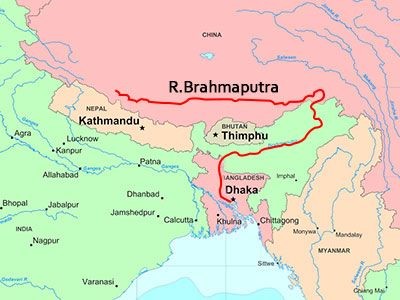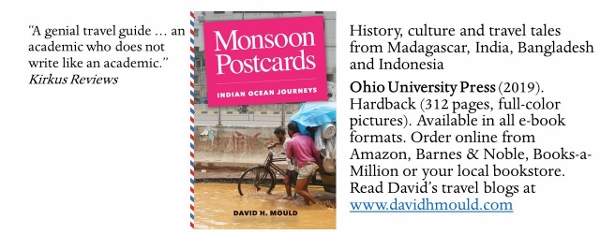“Anything we need to bring on the trip?” The agent at the tourist board office in Shillong in northeast India looked up from her ledger and smiled. It must have been a familiar question. “I’d recommend umbrellas,” she said matter-of-factly.
We had booked a day trip to the must-see destination of Cherrapunjee, an area of scenic waterfalls and caves about a two-hour drive south from Shillong near the border with Bangladesh. At 400 rupees ($6 each) it was a bargain. We could have paid more and hired a car, but we prefer traveling with other people. It was raining hard when we left the hotel. I was thinking that Shillong’s “Scotland of the East” label had as much to do with the weather as with the scenery. Technically, Shillong has a sub-tropical highland climate; in practice, that means that during the monsoon season, it rains most days. And some days it rains most of the day. Not the persistent drizzle I remember from hikes in the Lake District, Pennines and Yorkshire Moors, but a steady downpour.
We were the first to board the 30-seater bus and did not notice that our tickets had seat numbers. Other tourists—mostly from Delhi and Kolkata—got on and chose their places. As the bus filled, new arrivals started demanding their assigned seats. The young tour guide who had shown up late was not having much success mediating the seat disputes. People jammed into the narrow aisle or climbed over seats as everyone moved to their assigned places. Eventually, everyone was seated, if not happily. The seating disputes delayed our departure by almost half an hour, and the guide warned us we would have less time at the still-undisclosed number of stops. I wiped the condensation off the window and peered out into the driving rain, wondering if all the seating fuss was worth it because no one could not see much anyway. As we left the outskirts of Shillong, the mist thickened, further obscuring visibility. The road wound through low, grassy hills, with rice paddies in the valleys and terraced rows of tea plants on the hillsides; in places the hills were gouged open for sand, gravel and rock quarries. We passed small churches, with cemeteries on hilltops.
Our first stop was at a waterfall. “Just 10 minutes, please” the guide said. Stephanie and I surveyed the mist-filled valley and the treacherous, slippery steps descending to the viewing platform, and decided to have a cup of tea instead. We crossed the road to the small “hotel” and claimed a wooden bench. The guide had ordered his breakfast of eggs and Maggi noodles. The other tourists wandered in later, many of them ordering food. The 10-minute stop lasted almost an hour.
At the next stop—an ecological park where a waterfall begins its deep plunge—the rain had, if anything, intensified. We almost waded out to the viewing terrace, and looked down to see not mist, but clouds, with the occasional glimpse of the green valley below.
Back on the bus, tension was rising. The guide was describing the sights in English, angering two passengers who insisted he speak in Bengali. “It is the official policy to speak in English,” said the guide. Fortunately for him, passengers came to his defense, pointing out that they were Hindi speakers and did not understand Bengali.
We passed through the small town of Cherrapunjee, a straggle of houses and commercial buildings clinging to the slopes. In the local Khasi language, the settlement was called Sohra; the British called it “Churra,” which may have been how it sounded to them, and eventually it became Cherrapunjee. Today, its main claim to fame is that it is the wettest place in the world, holding the record for the most rainfall in one month (370 inches in July 1861) and in a year (1,042 inches between August 1, 1860, and July 31, 1861). That proved to be too much for even the rain-resistant British administrators, which is why they decamped to the balmier climes of Shillong. Cherrapunjee’s claims are hotly disputed by a nearby Khasi village, Mawsynram, which receives an average of 467 inches a year and got 1,000 inches dumped on it in 1985. “It used to rain every day,” a fellow passenger told me. “Now there are some dry days in December and January. Climate change, I suppose.” Despite all the rain, both places face an acute water shortage and the inhabitants often trek long distances to obtain potable water.
Our next stop, near the rainy village of Mawsynram, was the Mawsmai cave, known for its impressive stalagmites and stalactites. I made it about as far as most of the tourists—the first chamber. The passage ahead was narrow and under several inches of water. My feet were already wet. I figured I’d buy a postcard instead and went back to the bus.
At the final stop the rain had eased and we looked out towards Nohkalikai Falls, at 1,115 feet (340 meters) the highest plunge waterfall in India, and reportedly the sixth highest in the world. The name in the Khasi language means “jump of Ka Likai." According to legend, a poor woman named Ka Likai struggled to take care of her infant daughter after her husband’s death. She was forced to re-marry but her jealous new husband killed and cooked up the daughter. Returning from work as a porter, Ka Likai unknowingly ate the meat and then discovered a severed finger. Distraught, she flung herself over the cliff to her death.
As usual, mist and clouds blocked the view. Then a breeze moved through the valley, breaking the clouds. And suddenly there it was, the majestic Nohkalikai, plunging into a green pool below. Cameras clicked before the clouds moved in again.































































